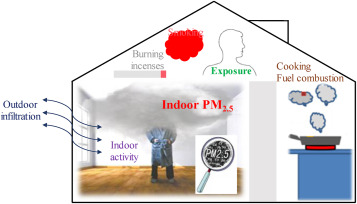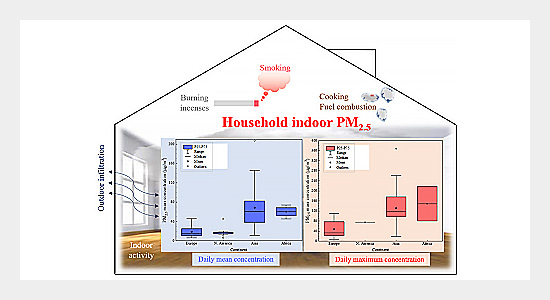Indoor air pollution is a significant public health concern, particularly in low-income and developing countries, where biomass fuels like wood, charcoal, and dung are commonly used for cooking. Among the most harmful pollutants found in indoor environments is particulate matter (PM), particularly PM 2.5. These are particles with diameters of 2.5 micrometers or less, small enough to penetrate deep into the lungs and even enter the bloodstream, causing respiratory and cardiovascular problems.
The study “Indoor PM 2.5 Exposure Rates Using Different Cooking Fuels, as Measured by Low-Cost Sensors” focuses on evaluating the levels of indoor PM 2.5 exposure generated by different cooking fuels and the use of affordable air quality sensors to monitor these emissions. This research is crucial for understanding how the choice of fuel affects indoor air quality and, consequently, the health of individuals exposed to indoor pollution on a daily basis.
The Health Risks of PM 2.5
indoor PM 2.5 exposure is a well-established health risk, as prolonged exposure to elevated concentrations can lead to a range of adverse health effects. These fine particles can aggravate conditions such as asthma, bronchitis, and other respiratory illnesses. They are also linked to more severe outcomes like heart attacks, strokes, and even premature death, particularly in vulnerable populations like children, the elderly, and people with preexisting conditions.
One of the primary sources of Indoor PM 2.5 Exposure in indoor environments is the combustion of cooking fuels. In many regions, particularly in rural or low-income areas, biomass fuels are the primary source of energy for cooking and heating. However, the burning of these materials releases high levels of particulate matter and other harmful pollutants such as carbon monoxide, sulfur dioxide, and nitrogen oxides into the air, leading to hazardous indoor air conditions.
Study Overview
The study examines three types of cooking fuels—biomass, natural gas, and electricity—to measure the levels of indoor PM 2.5 exposure emitted during cooking. The use of low-cost air quality sensors is emphasized, as these sensors offer a more accessible and affordable way to monitor indoor pollution in real-time.
Data from the study indicated that biomass fuels, particularly wood and charcoal, produced PM 2.5 levels that far exceeded international safety guidelines, including those set by the World Health Organization (WHO). In contrast, natural gas and electric cooking methods produced significantly lower levels of particulate matter, making them a safer alternative in terms of air quality.
Biomass Fuels: The Greatest Contributor to PM 2.5

Biomass fuels have long been a staple in many households around the world, especially in developing countries where access to cleaner fuels is limited. However, the study’s findings reinforce the fact that using biomass for cooking comes with significant health risks. When biomass fuels are burned, incomplete combustion results in high levels of Indoor PM 2.5 Exposure and other harmful pollutants, which accumulate in poorly ventilated homes. These particles remain suspended in the air for long periods, increasing the risk of exposure for inhabitants.
In some cases, the PM 2.5 levels measured in homes using biomass fuels were as high as 800 µg/m³, far exceeding the WHO recommended limit of 25 µg/m³ for a 24-hour exposure period. This exposure can have immediate effects, such as irritation of the eyes and respiratory tract, and long-term consequences, including chronic respiratory diseases and increased mortality.
Natural Gas and Electric Cooking: Cleaner Alternatives
On the other end of the spectrum, the use of natural gas and electric stoves was found to produce significantly lower levels of Indoor PM 2.5 Exposure. Homes using natural gas for cooking had indoor PM 2.5 exposure levels averaging around 200 µg/m³, while those using electric stoves saw concentrations as low as 50 µg/m³. Although natural gas combustion still produces some particulate matter, the levels are considerably lower than biomass fuels.
Electric stoves, which do not involve combustion, represent the cleanest option from an air quality perspective. The study highlights that switching to electric cooking can drastically reduce indoor PM 2.5 levels, thereby improving the health outcomes of residents, particularly in areas where biomass fuel use is prevalent.
The Role of Low-Cost Air Quality Sensors
A key feature of this research is the use of low-cost air quality sensors to measure PM 2.5 levels. These sensors provide an affordable and accessible way for households, particularly in resource-limited settings, to monitor indoor air pollution in real-time. Traditionally, air quality monitoring has required expensive equipment and technical expertise, making it inaccessible to many communities that could benefit the most from such data.
By utilizing low-cost sensors, the study demonstrates that it is possible to collect accurate and reliable data on indoor air quality without the need for costly equipment. This is particularly important for individuals and communities that rely on biomass fuels for cooking, as it allows them to better understand the risks they face and take action to improve ventilation or switch to cleaner fuels where possible.
Mitigation Strategies and Policy Implications
The study’s findings have significant implications for both public health policy and the promotion of sustainable energy solutions. Indoor PM 2.5 Exposure In regions where biomass fuels are the primary source of energy, there is an urgent need for policies that promote the transition to cleaner alternatives, such as natural gas or electricity. This could involve government subsidies or incentives to make these fuels more affordable and accessible to low-income households.
Improving ventilation in homes where biomass fuels are used can also help reduce the concentration of PM 2.5. Simple measures, such as installing chimneys or using more efficient stoves, can significantly lower indoor pollution levels and improve health outcomes.
Moreover, the adoption of low-cost air quality sensors could revolutionize the way air pollution is monitored and managed, particularly in resource-limited settings. These sensors empower individuals to take control of their indoor environments by providing real-time data on air quality, enabling them to make informed decisions about cooking practices and fuel choices.
Conclusion
The research conducted on indoor PM 2.5 exposure levels associated with different cooking fuels provides crucial insights into the health risks posed by indoor air pollution, particularly in areas where biomass fuels are commonly used. The findings underscore the need for a transition to cleaner cooking technologies, such as natural gas and electric stoves, to reduce exposure to harmful pollutants and improve public health outcomes.
Low-cost air quality sensors offer a promising solution for monitoring and managing indoor pollution in real-time, making it easier for households and policymakers to address air quality issues. As this technology becomes more widely available, it could play a key role in reducing the global burden of disease associated with indoor air pollution and promoting healthier living environments for all(





